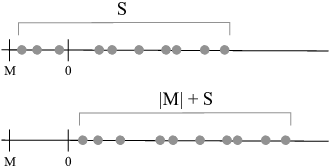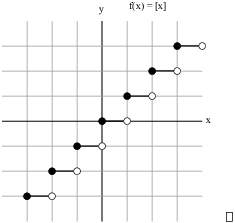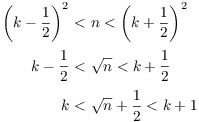The following theorem is an extension of the Well-Ordering Axiom. It will be used to justify the definition of the greatest integer function
Theorem.
(a) Suppose S is a nonempty set of integers which is bounded below: There is an integer M such that
![]() for all
for all ![]() . Then S has a smallest element.
. Then S has a smallest element.
(b) Suppose S is a nonempty set of integers which is bounded above: There is an integer M such that
![]() for all
for all ![]() . Then S has a largest element.
. Then S has a largest element.
Proof. (a) Suppose S is a nonempty set of
integers, and ![]() for all
for all ![]() . I'll consider two cases.
. I'll consider two cases.
First, if ![]() , then
, then ![]() for all
for all ![]() . This shows that S is a subset of the
positive integers, so it has a smallest element by the Well-Ordering
Axiom.
. This shows that S is a subset of the
positive integers, so it has a smallest element by the Well-Ordering
Axiom.
Next, suppose ![]() . In this case, the idea is to
"translate" S to the right to get a subset of the positive
integers to which Well-Ordering can be applied.
. In this case, the idea is to
"translate" S to the right to get a subset of the positive
integers to which Well-Ordering can be applied.

Consider the set
![]()
If ![]() , then
, then
![]()
This shows that the elements of ![]() are positive integers. By Well-Ordering,
are positive integers. By Well-Ordering,
![]() has a smallest element y. Thus,
has a smallest element y. Thus, ![]() , and
, and ![]() for all
for all ![]() .
.
Since ![]() , I can write
, I can write ![]() for some
for some ![]() .
.
Now if ![]() , then
, then

Thus, z is an element of S which is at least as small as any other element of S --- that is, z is the smallest element of S.
(b) Suppose S is a nonempty set of integers and ![]() for all
for all ![]() . Then
. Then ![]() for all
for all ![]() , so the followng set is bounded below
, so the followng set is bounded below
![]()
By part (a), ![]() has a smallest element. Suppose
that y is the smallest element of
has a smallest element. Suppose
that y is the smallest element of ![]() . Thus,
. Thus, ![]() , and
, and ![]() for all
for all ![]() .
.
Since ![]() , I can write
, I can write ![]() , where
, where ![]() .
.
Now if ![]() ,
,

Thus, z is an element of S which is at least as large as any other
element of S --- that is, z is the largest element of S.![]()
Definition. If x is a real number, then ![]() denotes the greatest integer
function of x. It is the largest integer less than or equal to
x.
denotes the greatest integer
function of x. It is the largest integer less than or equal to
x.
It's probably obvious to you based on your experience with the real
numbers that there is such an integer ![]() . You might find justifying this a bit of a
challenge. Here's the idea.
. You might find justifying this a bit of a
challenge. Here's the idea.
For every real number x, the Archimedean Axiom
for the real numbers says that there is an integer n such that ![]() .
.
Lemma. For every ![]() , there is an integer m such that
, there is an integer m such that ![]() .
.
Proof. Apply the Archimedean Axiom to ![]() to get an integer n such that
to get an integer n such that ![]() . Negating the inequality, I get
. Negating the inequality, I get ![]() . Then
. Then ![]() is an integer less than x.
is an integer less than x.![]()
Now go back to the greatest integer function. Let ![]() . Why is there a largest integer less than
or equal to x?
. Why is there a largest integer less than
or equal to x?
First, the lemma shows that there is an integer less than x, so the set S of integers less than or equal to x is nonempty.
Second, S is bounded above by x. By the Archimedean Axiom, there is
an integer n such that ![]() . Then n is also an
upper bound for S.
. Then n is also an
upper bound for S.
By part (b) of the theorem, S has a largest element. That element is
![]() .
.
That was a lot of work to show that the function ![]() is actually defined, particularly since this fact was
probably obvious to you form the start!
is actually defined, particularly since this fact was
probably obvious to you form the start!
When you learn about "ordinary" math like calculus, or number theory, you usually "start in the middle": A lot of things (that are hopefully plausible) are taken for granted. We don't normally go back to the very basic axioms, and perhaps this discussion helps you understand why we don't: We'd have to go through a lot of technicalities, and we wouldn't have the time to get to the ideas of calculus or number theory.
The following lemmas and examples should give you some ideas about how to work with the greatest integer function.
Example. Compute ![]() ,
, ![]() , and
, and ![]()
![]()
(Notice that ![]() is not
equal to -1.)
is not
equal to -1.)![]()
Example. Sketch a graph of ![]() .
.

Lemma. If x is a real number, then
![]()
Proof. By definition, ![]() . To show that
. To show that ![]() , I'll give a proof by
contradiction.
, I'll give a proof by
contradiction.
Suppose on the contrary that ![]() . Then
. Then ![]() is an integer less than or equal to x, but
is an integer less than or equal to x, but
![]() --- which contradicts the fact
that
--- which contradicts the fact
that ![]() is the largest integer less than
or equal to x. This contradiction implies that
is the largest integer less than
or equal to x. This contradiction implies that ![]() .
.![]()
Lemma. If ![]() and
and ![]() , then
, then ![]() .
.
Proof. Suppose ![]() . I want to show that
. I want to show that ![]() .
.
Assume on the contrary that ![]() . Since
. Since ![]() is the {\it greatest} integer which is less than or
equal to x, and since
is the {\it greatest} integer which is less than or
equal to x, and since ![]() is an integer which is
greater than
is an integer which is
greater than ![]() , it follows that
, it follows that ![]() can't be less than or equal to x. Thus,
can't be less than or equal to x. Thus, ![]() . But
. But ![]() , so
, so ![]() , which is a contradiction.
, which is a contradiction.
Therefore, ![]() .
.![]()
Example. Let x be a real number and let n be
an integer. Prove that ![]() .
.
First, ![]() , so
, so ![]() . Now
. Now ![]() is an integer less than or equal to
is an integer less than or equal to ![]() , so it must be less than or equal to the
greatest integer less than or equal to
, so it must be less than or equal to the
greatest integer less than or equal to ![]() --- which is
--- which is ![]() :
:
![]()
Next, ![]() , so
, so ![]() .
. ![]() is an integer less than or equal to x.
Therefore, it must be less than or equal to the greatest integer less
than or equal to x --- which is
is an integer less than or equal to x.
Therefore, it must be less than or equal to the greatest integer less
than or equal to x --- which is ![]() :
:
![]()
Adding n to both sides gives
![]()
Since ![]() and
and ![]() , it follows that
, it follows that ![]() .
.![]()
Example. Consider the sequence
![]()
Show that it consists of two 1's, four 2's, six 3's, and so on:
![]()
Note that for ![]() , the expressions
, the expressions ![]() and
and ![]() are not
integers. In addition,
are not
integers. In addition,
![]()
Thus, the interval ![]() contains
contains ![]() integers.
integers.
Now

Hence, ![]() .
.
That is, if n is one of the ![]() integers between
integers between ![]() and
and ![]() , the
value of
, the
value of ![]() is k. This shows that the given sequence consists of
two 1's, four 2's, six 3's, and so on.
is k. This shows that the given sequence consists of
two 1's, four 2's, six 3's, and so on.![]()
Copyright 2019 by Bruce Ikenaga